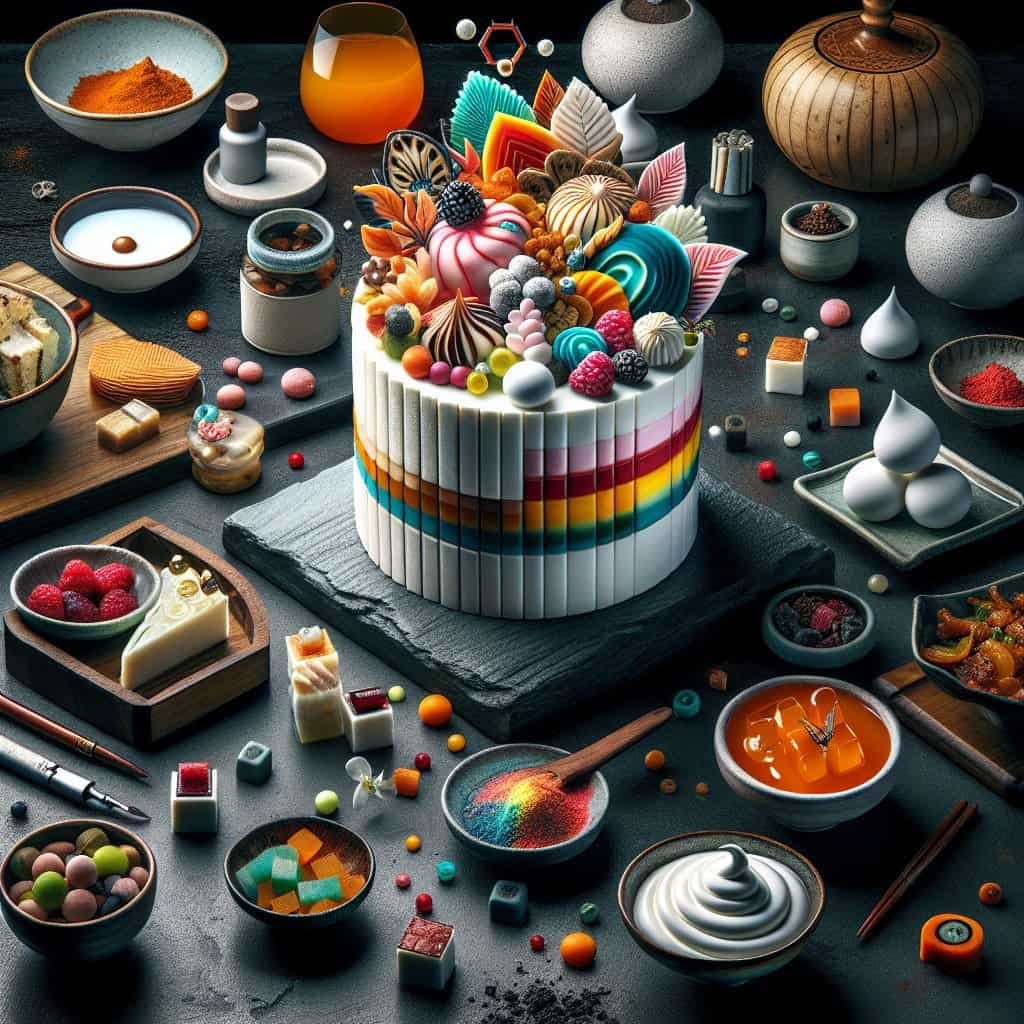If you’re a fan of traditional Korean desserts but want to switch things up with a modern touch, we’ve got some exciting ideas for you. Adding a contemporary twist to these beloved treats allows you to experience the best of both worlds – the rich cultural heritage of Korean desserts and the innovative flavors of today. From incorporating unexpected ingredients to presenting desserts in new and creative ways, there are endless possibilities to explore. So, get ready to embark on a delightful journey as we show you how to add a contemporary twist to traditional Korean desserts.

Experiment with flavors
Combine traditional flavors with unexpected ingredients
One way to add a contemporary twist to traditional Korean desserts is by experimenting with flavors. Combine the familiar taste of traditional ingredients with unexpected and unconventional flavors to create unique and exciting flavor combinations. For example, you can add a touch of floral sweetness to the traditional rice cake, Tteok, by infusing it with rose or lavender flavors. The combination of the familiar chewy texture of Tteok with the subtle floral notes adds a modern and unexpected twist to this beloved dessert.
Infuse desserts with popular international flavors
Another way to inject a contemporary flair into traditional Korean desserts is by infusing them with popular international flavors. Take inspiration from different cuisines and incorporate flavors like matcha, coconut, or mango into traditional Korean desserts. For instance, a classic Korean dessert like Bingsu, a shaved ice dessert, can be transformed into a refreshing tropical treat by incorporating flavors and toppings commonly found in Southeast Asian desserts, such as mango and coconut milk.
Create unique flavor combinations
To truly make traditional Korean desserts stand out in a contemporary setting, experiment with unique flavor combinations. Mix traditional Korean ingredients like red bean paste or honey with unexpected flavors like citrus, spices, or even herbs. By blending contrasting flavors together, you can create an innovative twist on traditional desserts. For instance, pairing the earthy sweetness of red bean paste with a zesty lemon or a hint of cinnamon can elevate the flavor profile of a classic Korean sweet pancake, Hotteok.
Play with textures
Introduce contrasting textures to traditional desserts
Texture plays a vital role in the overall dining experience, and by introducing contrasting textures to traditional Korean desserts, you can add a modern twist. For example, you can add a crunchy element like crushed nuts or crispy rice to a soft and chewy dessert like Mochi. The combination of textures creates an exciting contrast that adds depth to the dessert, making it more interesting and enjoyable to eat.
Experiment with new techniques to alter textures
In addition to introducing contrasting textures, experimenting with new techniques can also help alter the textures of traditional Korean desserts. For instance, instead of the traditional steamed or boiled method, try baking or frying rice cakes to achieve a different texture. Baking can result in a slightly crispy exterior while maintaining a soft and chewy interior, providing a unique textural experience.
Incorporate crunchy or creamy elements
To give traditional Korean desserts a contemporary twist, consider incorporating elements that are either crunchy or creamy. Add a layer of caramelized sugar on top of a custard-filled rice cake to create a delightful crunchy texture. Alternatively, you can infuse cream or cream-based sauces into traditional Korean desserts to introduce a smooth and luscious element. These contrasting textures bring a modern touch to traditional desserts, making them more exciting and indulgent.

Present desserts in a modern way
Use creative plating techniques
When it comes to adding a contemporary twist to traditional Korean desserts, presentation plays a crucial role. Experimenting with creative plating techniques can transform the appearance of the dessert, making it visually appealing to the modern diner. Use unique and unconventional plating styles, such as stacking or creating intricate designs with sauces and garnishes, to elevate the visual appeal of traditional desserts.
Incorporate modern serving vessels
In addition to creative plating techniques, using modern serving vessels can also enhance the overall presentation of traditional Korean desserts. Instead of using traditional bowls or plates, consider serving individual portions in elegant glass jars, mini mason jars, or even edible containers. These modern serving vessels not only provide a visually appealing presentation but also create a memorable and enjoyable dessert experience.
Focus on visual appeal
To give traditional Korean desserts a contemporary makeover, focus on the visual appeal of the dish. Pay attention to the colors, shapes, and arrangement of the dessert components. Incorporate vibrant and contrasting colors to make the dessert visually striking. Experiment with different shapes and sizes of the dessert elements to create an artistic and visually pleasing composition. By prioritizing the visual aspects, traditional Korean desserts can become not just a treat for the taste buds but also a feast for the eyes.
Add a contemporary twist to traditional ingredients
Use unconventional ingredients as substitutes
One way to add a contemporary twist to traditional Korean desserts is by using unconventional ingredients as substitutes. Replace traditional ingredients with modern alternatives that can elevate the flavor profile or add an unexpected element. For example, replacing white sugar with coconut sugar in a Korean rice drink called Sikhye can result in a more complex and earthy flavor profile.
Transform traditional ingredients into new forms
Another way to give traditional Korean desserts a contemporary twist is by transforming traditional ingredients into new forms. For instance, instead of using red bean paste in its traditional form, consider turning it into a silky smooth cream or incorporating it into a creamy filling for a pastry. By transforming the texture and presentation of traditional ingredients, you can create unique and modern interpretations of classic Korean sweets.
Incorporate trendy superfoods
Incorporating trendy superfoods into traditional Korean desserts is a great way to add a contemporary touch. Superfoods like matcha, chia seeds, or goji berries not only bring added nutritional value but also add interesting flavors and textures to desserts. For example, incorporating matcha powder into a traditional Korean rice cake, Songpyeon, provides a vibrant green color and a subtly bitter flavor that complements the sweetness of the rice cake.
Fusion of traditional and modern cooking techniques
Combine traditional and molecular gastronomy techniques
To add a contemporary twist to traditional Korean desserts, consider combining traditional cooking techniques with modern culinary methods like molecular gastronomy. For example, you can use sous vide cooking to infuse traditional Korean flavors into custards or use spherification techniques to create unique gelatinous textures in jellied desserts. By merging traditional and modern techniques, you can create innovative and visually stunning desserts.
Incorporate modern baking methods
Incorporating modern baking methods can also give traditional Korean desserts a contemporary edge. Experiment with techniques like air frying to achieve a crispy and golden exterior or use a blowtorch to caramelize the top of a dessert for an irresistible caramelized flavor and texture. These modern baking methods can transform traditional Korean desserts and bring them into the modern culinary landscape.
Experiment with unconventional cooking tools
To further fuse traditional and modern cooking techniques, experiment with unconventional cooking tools. For instance, instead of using a traditional stove or oven, try using a sous vide machine to cook Korean custards or a smoking gun to add a smoky flavor to desserts. Using unconventional cooking tools not only adds a contemporary twist to traditional Korean desserts but also introduces new flavors and textures that elevate the overall dining experience.
Make use of innovative technology
Utilize molecular gastronomy techniques
Innovative technology, particularly molecular gastronomy techniques, can be incorporated to add a contemporary touch to traditional Korean desserts. Techniques like foams, gels, and liquid nitrogen can create visually exciting and texturally unique elements in desserts. For example, using liquid nitrogen to freeze a traditional Korean ice cream, Patbingsu, can result in a creamy and instantly frozen treat that melts in your mouth.
Experiment with 3D printing for decorative elements
Another way to embrace innovative technology is by using 3D printing for decorative elements in traditional Korean desserts. Custom-designed 3D printed molds can be used to create intricate shapes and patterns that add a modern and artistic touch to desserts. For example, 3D printed chocolate sculptures or sugar decorations can transform a simple Korean rice cake into a visually stunning masterpiece.
Incorporate modern kitchen gadgets
Incorporating modern kitchen gadgets can also enhance traditional Korean desserts. Devices like immersion blenders, dehydrators, or even liquid nitrogen dispensers can be used to create unique textures, flavors, and presentations. For instance, using an immersion blender to create a velvety smooth fruit puree or a dehydrator to create crispy fruit chips can add depth and complexity to traditional Korean desserts.

Experiment with presentation styles
Deconstruct traditional Korean desserts
To add a contemporary twist to traditional Korean desserts, experiment with deconstructing them and presenting their components in a unique way. Instead of serving a whole dessert, deconstruct it into separate layers or elements and arrange them artfully on the plate. For example, deconstructing a Korean rice cake dessert, Yakgwa, and arranging its fried dough, honey, and sesame seeds separately can create an innovative and visually striking presentation.
Create interactive dessert experiences
Incorporating interactive elements into the presentation of traditional Korean desserts can make the dining experience more engaging and memorable. For instance, serving a Korean rice punch, Sikhye, with flavored syrups or garnishes on the side, allowing the diner to customize their drink, adds an interactive element. Interactive dessert experiences provide a modern twist, making the dining experience more immersive and enjoyable.
Present desserts as art installations
For a truly contemporary presentation, consider presenting traditional Korean desserts as art installations. Use edible paints, powders, and garnishes to create visually stunning designs and patterns on the plate. Treat the dessert as a canvas and arrange the components in a way that resembles an art piece. By transforming traditional Korean desserts into edible works of art, you create a memorable and Instagram-worthy experience.
Offer healthier alternatives
Use alternative sweeteners
To cater to the growing demand for healthier options, offer traditional Korean desserts with alternative sweeteners. Replace refined white sugar with natural sweeteners like honey, agave syrup, or maple syrup. Additionally, explore the use of alternative sweeteners like stevia or monk fruit extract for low-calorie options. By incorporating alternative sweeteners, traditional Korean desserts can be enjoyed by those seeking healthier alternatives without sacrificing flavor.
Incorporate more nutritious ingredients
Another way to offer healthier alternatives is by incorporating more nutritious ingredients into traditional Korean desserts. Add fruits like berries, pomegranates, or kiwi to provide essential vitamins and antioxidants. Substitute refined flour with whole wheat flour or incorporate grains like quinoa or amaranth to add fiber and nutrients. By incorporating nutritious ingredients, traditional Korean desserts can become a guilt-free indulgence.
Create low-sugar or gluten-free options
To cater to specific dietary needs, offer low-sugar or gluten-free options of traditional Korean desserts. Reduce the sugar content or replace it with natural sweeteners for those who are watching their sugar intake. Additionally, explore gluten-free flours like almond flour or rice flour to create gluten-free variations of classic Korean sweets. By providing these alternatives, traditional Korean desserts can be enjoyed by a wider range of individuals with specific dietary requirements.

Collaborate with other culinary experts
Partner with renowned chefs for innovative recipes
Collaborating with renowned chefs can bring fresh perspectives and innovative recipes to traditional Korean desserts. Partnering with chefs known for their expertise in fusion cuisine or modern culinary techniques can result in exciting flavor combinations, unique presentations, and unexpected twists on traditional Korean desserts. By joining forces, traditional Korean desserts can be elevated to new culinary heights.
Join forces with mixologists for dessert and cocktail pairings
For a truly unique dining experience, consider collaborating with mixologists to create dessert and cocktail pairings. By incorporating traditional Korean flavors and ingredients into craft cocktails that complement the flavors of the desserts, you can offer a cohesive and immersive dining experience. For example, pairing a tangy grapefruit-infused Korean dessert with a citrusy soju cocktail can create a delightful balance of flavors.
Collaborate with food stylists for eye-catching presentations
Collaborating with food stylists can help elevate the visual appeal of traditional Korean desserts. Food stylists are experts at arranging and presenting food in the most visually appealing way possible. By working together, you can create stunning presentations that capture the essence of traditional Korean desserts while adding a contemporary twist. The collaboration between culinary and visual arts enhances the overall dining experience and makes the desserts more enticing.
Take inspiration from other contemporary desserts
Adapt techniques from popular Western desserts
Drawing inspiration from popular Western desserts and adapting their techniques to traditional Korean desserts can create exciting and innovative treats. For instance, incorporating the technique of layering and assembling found in Western cakes into a traditional Korean dessert like Yeot, a sticky taffy-like candy, can result in visually impressive and multi-flavored treats. By combining the best of both worlds, traditional Korean desserts can gain a contemporary appeal.
Incorporate elements from trendy Asian desserts
To stay ahead of dessert trends and offer contemporary creations, incorporate elements from trendy Asian desserts into traditional Korean sweets. For example, using the delicate jelly-like texture of Japanese Mochi as a wrapping for a traditional Korean rice cake, Injeolmi, can create a unique fusion of textures and flavors. By incorporating elements from other Asian desserts, traditional Korean sweets become even more diverse and appealing to a wider audience.
Explore global dessert trends
Keeping up with global dessert trends can inspire new and innovative creations for traditional Korean desserts. Stay informed about the latest dessert trends from around the world and adapt them to fit traditional Korean flavors and ingredients. For instance, incorporating the trend of “freakshakes” into a traditional Korean drink like Sikhye by adding over-the-top toppings and elaborate garnishes can create a dessert experience that is both visually striking and indulgent.
In conclusion, adding a contemporary twist to traditional Korean desserts involves experimenting with flavors, textures, presentation styles, ingredients, cooking techniques, technology, and collaborations. By combining traditional elements with innovative techniques and global influences, traditional Korean desserts can be elevated to new and exciting levels. Whether it’s infusing flavors, introducing contrasting textures, incorporating modern technology, or collaborating with culinary experts, the possibilities for creating contemporary Korean desserts are endless. Embrace creativity, experiment fearlessly, and be open to the fusion of tradition and innovation to create delightful and unforgettable dessert experiences.

